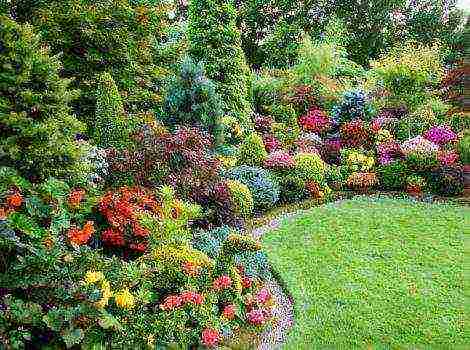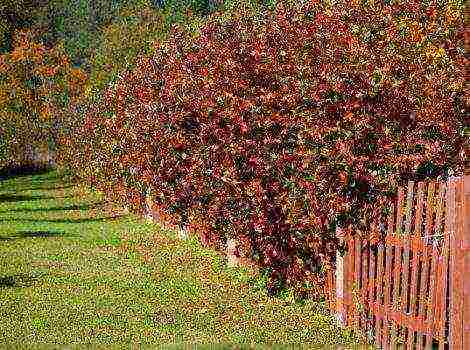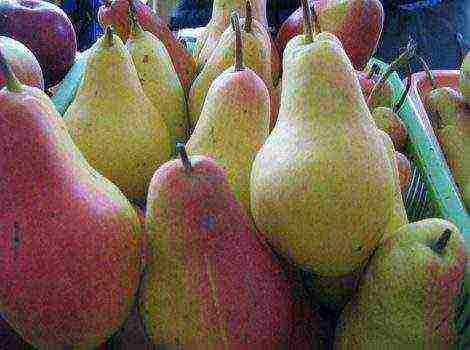Content
Many gardeners grow plums on their plots. This culture has more than 250 varieties., some of which are grouped together. One of these families is called Renclaude, the varieties included in it have a number of similar characteristics, but at the same time they differ from each other. Let's take a closer look at this type of plum.
Renklody differs from other varieties of plums primarily by its excellent taste. Their fruits have a dessert taste, tender pulp that melts in your mouth..
Also, the trees of this family look neat and beautiful, few varieties of the crown need shaping pruning.
Description of varieties
The Renclaude species includes several varieties that differ in similar characteristics:
- Average, tree height is 4-6 meters.
- Spherical crown, small deviations are allowed.
- Young branches slightly pubescent, easy to bend, painted red-brown or red-green. Over time, they harden and acquire a grayish tint.
- On the veins of leaves fluff is also present.
- Most often the fruit is in the shape of a ball, 4-5 centimeters long, the color ranges from yellow-green to inky purple. Plums of this family are slightly rough.
- Peduncle short, pubescent.
- Taste such plums are considered dessert.
- Most varieties are self-fertile and need additional pollination.
- Yield depends on how dry and sunny the summer was.
Collective farm
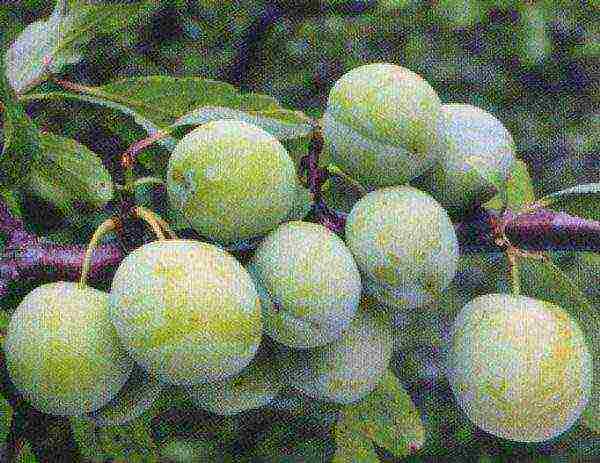
This variety was bred by I.V. Michurin at the end of the 19th century, Ternoslum and Green Renklode were used as parent plants... The resulting hybrid is zoned for central Russia, and is successfully grown in these areas. On average, the height of the tree is 2.5 meters, the crown is spreading, but not dense, it grows in the shape of a ball.
The size of the hearth is considered small, on average, one plum weighs 15-20 grams. The skin is yellow-green in color with many subcutaneous points, with prolonged exposure to sunlight, a brick blush may form. The wax coating is very easy to wear off. The flesh of the fruit is tender, juicy, but sour in comparison with other renklods.
Fruiting occurs at the end of August, on average, from one young tree they collect 20 kilograms harvest, and from an adult 40... The variety tolerates winter frosts down to -30 degrees. It is immune to many diseases, except fungal. The tree requires additional pollination.
Soviet
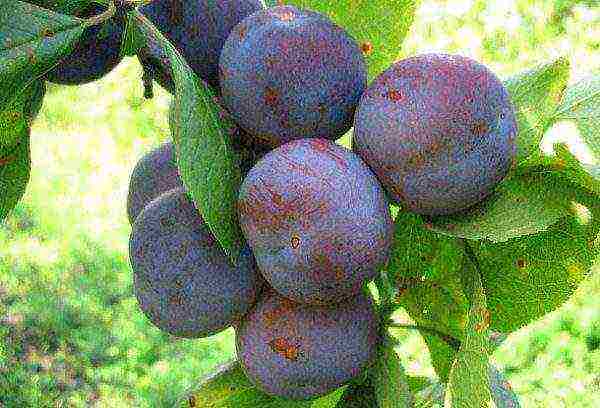
Was bred in the 80s, by cross-pollination of the plum Renklode and Renklode Ulyanishchev, zoned for the Central black earth region. The crown of the tree is not neat, with a small amount of foliage, the branches grow upward, gradually expanding, the growth of the hybrid does not exceed 3.5 meters.
Fruits weigh by 40 gram, round shape... The skin is dark purple with a waxy coating, the pulp is amber. The taste of plums is sweet, with a slight sourness.
Renklod Sovetsky tolerates frosts down to -30 degrees well. Fruiting begins at 4-5 years of age, 15-20 kilograms of harvest are harvested from a young tree, and 40-45 from an adult. The variety fully ripens by the end of August. Poor resistance to polystygmosis.
Early
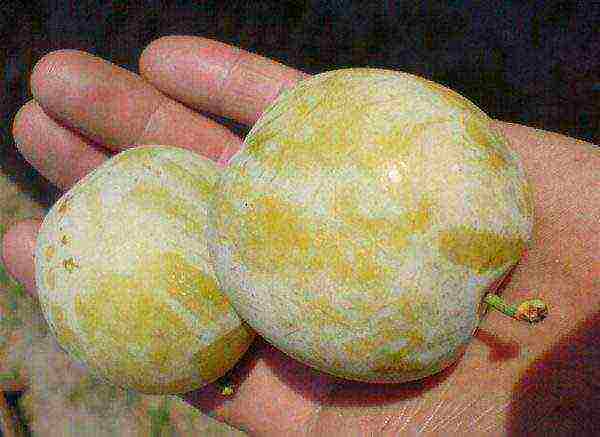
Bred in Ukraine in the 1950s by cross-pollination of varieties Jefferson and Peaches. The tree grows up to 6 meters, the crown is spherical, not dense.
The weight of one fruit is 60 grams, with age the tree gives a smaller yield, 35-40 grams. The plum is round, slightly flattened on the sides, the seam is clearly visible, one half is larger than the other. The skin is yellow-orange with a slight whitish bloom. The pulp is sweet and sour, with a honey flavor. The bone is not separated well.
The harvest ripens in late July - early August. The tree tolerates frost well up to -30 degrees and intense heat... The fruits are well transported.
Altana
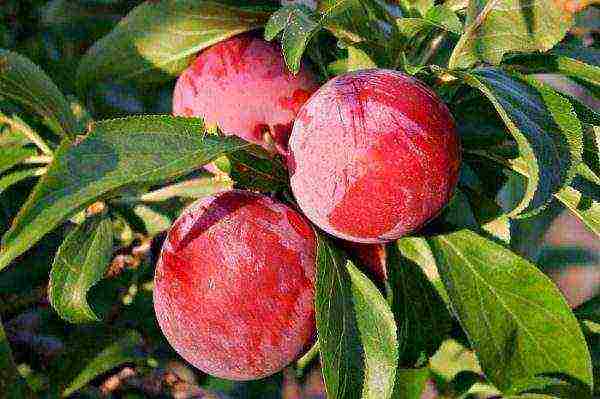
The hybrid appeared in the 19th century in the Czech Republic, by spontaneous mutation when grown from the green Renklode bone. In Russia, it is grown in the Central Black Earth Region. The tree grows up to 6.5 meters, spherical crown.
The plums themselves are large, 40-45 grams, slightly compressed at the sides. The skin of a salad color is covered with a red-pink blush, the presence of dark subcutaneous dots is characteristic. The pulp is amber in color, very tender and tasty.
The first crop can be removed as early as the 3rd year of life, the tree brings 35-40 kilograms, then this figure increases to 80 kilograms. Fruiting falls at the beginning of August; in regions with a colder climate, this period is postponed by about 2 weeks. The hybrid tolerates drought, frost, diseases and insect attacks well. The variety is self-fertile.
Tambov
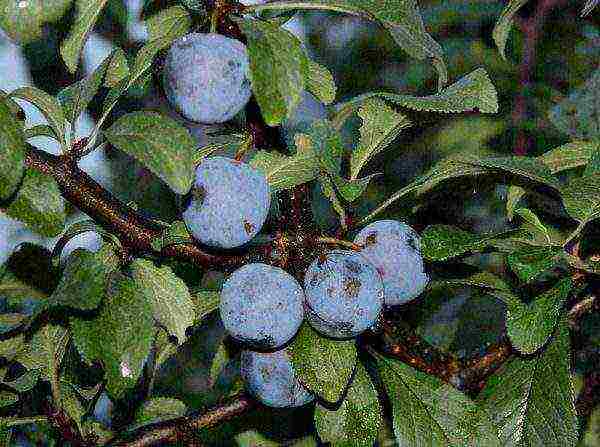
The hybrid was bred by crossing Green Renklode and Red Skorospelka. Grown in central Russia. Buds are well resistant to frost up to -30 degrees, shoots are less winter-hardy. The height of the tree is 3.5 meters, the crown is spreading, growing in width.
Fruit weight is only 20 grams... Elongated plums with a bluish-purple skin. The pulp is golden, sour.
The first crop can be harvested in early September as early as the 3rd year of life. On average, one tree gets 15-25 kilograms fruit... Tambovskiy does not well resist clasterosporium disease. The variety is self-fertile. To obtain a harvest, pollinating plums are grown nearby.
Karbysheva
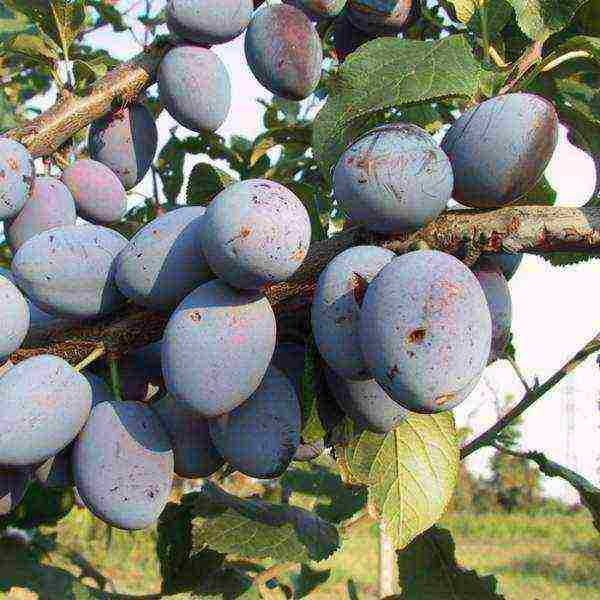
Renklod Karbyshev was bred in the 1950s in Ukraine. The tree grows very quickly, so you need to cut it off in time to form the crown..
Initially, the fruits weigh 50 grams, then their size is reduced to 35 grams. The skin is dense, bright scarlet; when overripe, a blue waxy coating appears. The pulp is honey-colored, it is considered dessert to taste and is highly appreciated by professionals.
The fruits ripen in the second half of August. The tree receives significant damage at temperature -20 degrees... The variety is self-fertile; Renklod Ranniy, Renklod Zeleny, Vengerka Donetskaya are usually used as pollinators.
White
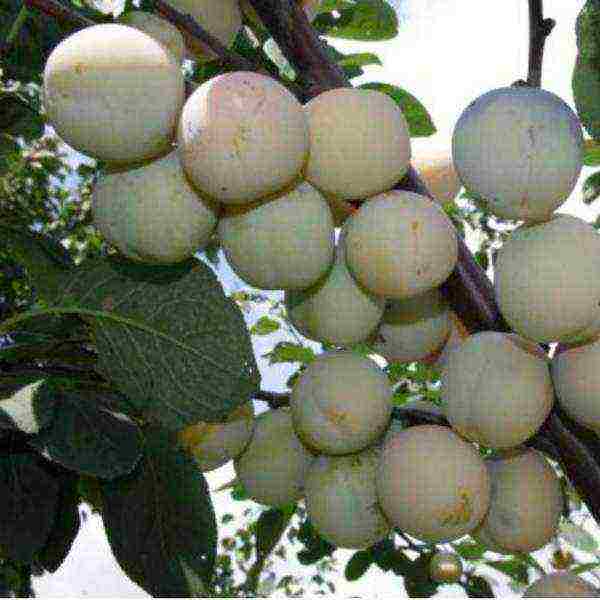
The tree grows up to 4 - 4.5 meters in height.
Fruits are dull, white, about 35-40 grams... The pulp is almost transparent, very sweet, juicy, melting in the mouth.
The harvest ripens at the end of August. The variety tolerates cold and prolonged droughts well.... The first fruiting occurs in the 3rd year of life. Requires additional pollination.
Green
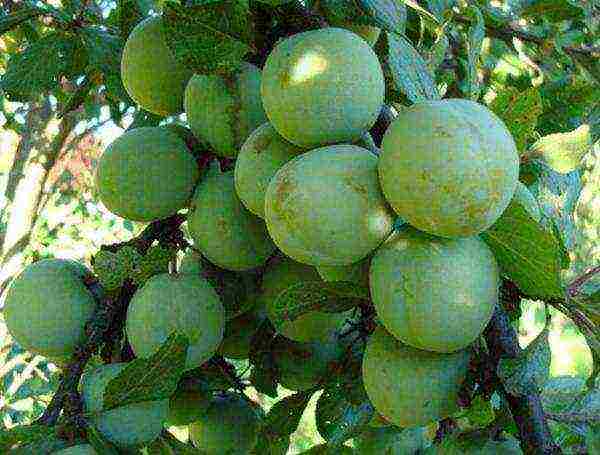
The tree grows up to 6-7 meters, and the diameter of the oval, spreading crown is equal to the same figures. On the territory of Russia, the variety is grown in the southern regions.
The fruits weigh only 20 grams, green-yellow skin with a gray waxy bloom... Initially, it seems that the pulp has the same shade, but after cleaning the plum, it turns out that its pulp is transparent. The taste is very delicate, juicy, sweet. It is a reference.
Fruiting occurs 5 years after the tree is transplanted into open ground. Initially, you can get 25-30 kilograms of harvest, but starting from the 10th year of life, gardeners collect 45-50 kilograms of plums... The fruits ripen at the end of August. The variety is well protected from fungal diseases, but is prone to rotting. Is self-fertile.
Beauvais
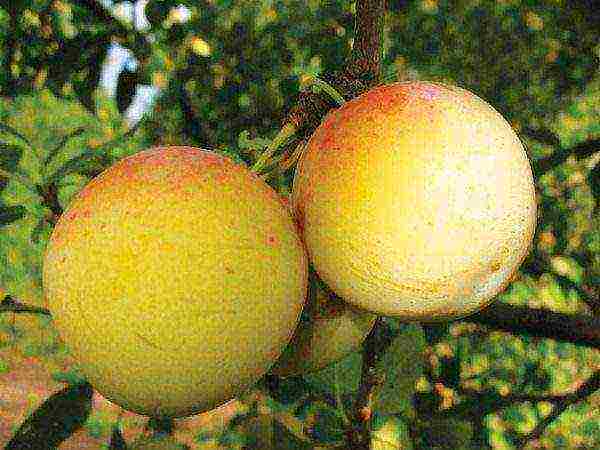
The cultivar was bred in Belgium by random mutation of a seedling grown from the seed of a green rennlode. A tree of medium height, branches grow in different directions, forming an untidy crown.
Plums are yellow-green in color with a crimson blush on the sides. The shape is spherical. There is a thick silvery waxy coating on the skin. The pulp is tender and sweet, with a slight aftertaste of nutmeg. The fruits tolerate transportation well and are stored for a long time..
The variety is self-fertile, the fruits ripen in mid-September. The yield of such a tree is excellent, at the age of 10 it brings 40-50 kilograms drains, and at 20 years old this number doubles... The winter hardiness of the variety is poor, but there is an immunity to the plum moth.
Michurinsky

It was bred at the beginning of the 21st century using the cross-pollination of the Eurasia 21 plum and Renclaude Altana. Small tree with a neat, spherical crown.
Fruit weight 25-30 grams, the skin is red-violet... The pulp is yellow-orange in color with a slight sourness.
Plums ripen in early September. Fruiting begins from 3 years after planting, on average, one tree is harvested 20-25 kilograms harvest... The variety is distinguished by good frost resistance and transportability. It is self-fertile, but with pollinator plums it gives the best yield.
Kuibyshevsky
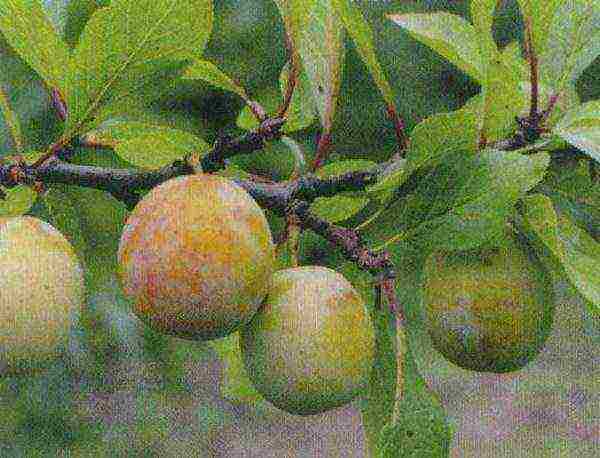
It was bred using the varieties Zheltaya localnaya and Lenya, in the mid-50s of the last century, especially for the northern part of Russia. The tree grows up to 6 meters in height, spreading crownI. Fruits are tied on 2 or 3-year-old bouquet branches.
Weight of drains approx. 25 grams, spherical shape... Lime-colored skin with rounded specks. The pulp is juicy, with sourness, a couple of shades lighter than the skin.
A young tree brings 6-8 kilograms of harvest, and an adult 20-30. Fruits ripen at the end of August.
Good frost and insect resistance, the variety is prone to gum flow. It is also self-fertile, but pollinators are encouraged.
Presidential
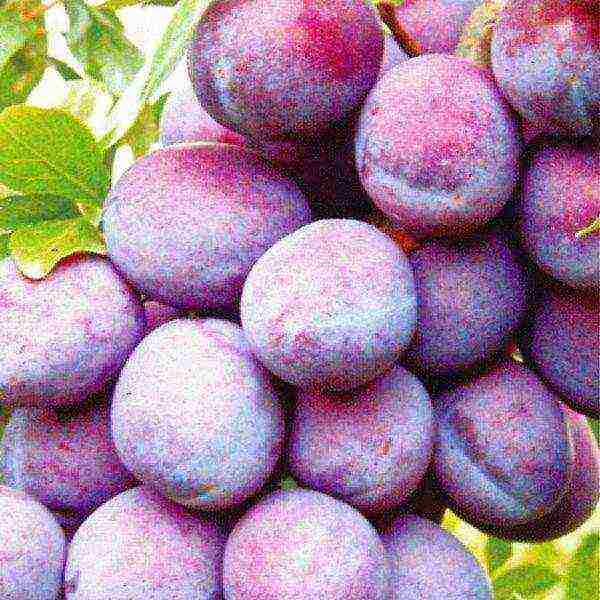
It was bred using the varieties Renklod Altana, Vengerka Azhanskaya and Velikaya blue plum. The tree grows up to 4 meters in height, the crown resembles a broom turned upside down by the handle.
The fruits ripen in mid-September and weigh 55-60 grams on average, are elliptical. The skin is dense, purple. The pulp is dense, juicy, granular, yellow-orange in color, taste with noticeable sourness.
The variety begins to bear fruit in the 4th year of cultivation, initially the yield is 12-15 kilogramsthen it rises up to 45... The frost resistance of the variety is excellent, but there is a susceptibility to gum flow, moniliosis, plum moth and aphids. For pollination, varieties of self-fertile plums are planted nearby.
Tenkovsky
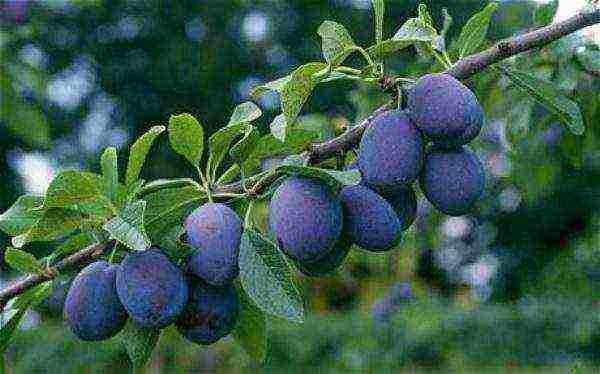
The parent varieties were Tatar yellow plum, Jefferson, Renklode Reforma, and local thorn. Small tree, total 3 meters... The crown is neat, shaped like a ball.
The fruits weigh 15-20 grams, the shape is round, while one half of the plum is noticeably larger than the other. The skin is purple in color with a bluish tinge, adding bitterness to the taste of the fruit. The pulp is yellowish, granular, not juicy, the taste is sweet and sour.
The first fruiting occurs at 4-5 years of age, the harvest ripens by mid-September... The variety does not differ in frost resistance and tolerance to drought and heat. Often exposed to rust, clotterosporia and attack by a mucus sawer.
Breeding history
Renclode began to be grown in France in the second half of the 16th century. King Francis was the first during his reign to receive a variety of plums as a gift, bred with the Verdicchio plum.... After the king tasted the gift, he demanded to name the brought variety in honor of his wife Claudine (Claude), noting that the taste of these fruits is as delicate and sweet as the appearance and character of the queen.
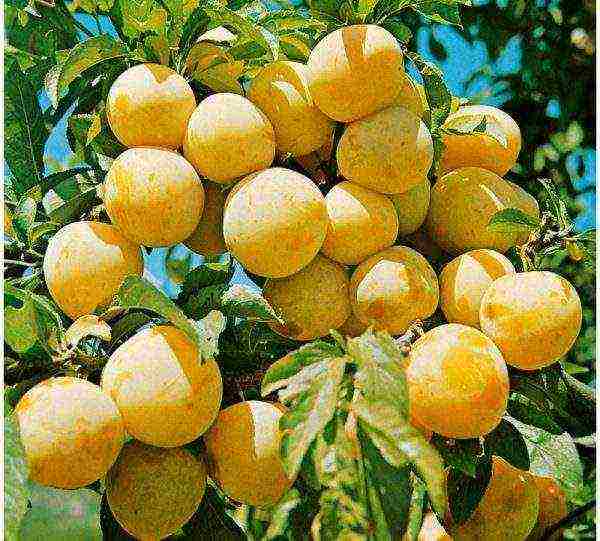
The name of this variety, ReineClaude, translates from French as Queen Claude.
Then gradually hybrids began to appear, similar in taste to Renclaude. They began to be combined into one group, while giving each variety its own individual, clarifying name.
Advantages and disadvantages of the variety
- Renclaude is distinguished by its excellent taste.
- Also, all fruits have attractive appearance.
- Most varieties have resistant to winter frosts and diseases.
- Most often trees belonging to the Renclaude species tie the maximum amount of harvest.
- Almost all varieties in the family are self-fertile and need additional pollination.
- Trees prone to root rot.
- It is necessary to provide reliable gusty wind protection.
Region of natural growth
Usually Renklods are grown in Western Europe. In Russia, however, such varieties can most often be found in the Central region or in the south of the country.... Stopping your choice on such a family, you should take a responsible approach to the choice of a subspecies, so that it can easily endure the climatic conditions of the growing region.
Planting rules for seedlings
Ranclode can only be planted in spring, in April, before bud break. So that the plum gives a good harvest and is healthy, when choosing a landing site, they are repelled by the following factors:
- The soil should be fertile and loose, it is best to use slightly acidic or neutral soil.
- Plot should be open and sunny, in the shade the amount of harvest will be much less.
- Necessary avoid places with high groundwater levels, excess moisture can lead to the development of various diseases.
- Same do not plant plums in low-lying placeswhere rain and melt water accumulates.
- The tree is needed protect from drafts and strong gusts of wind, therefore, they are planted next to a high fence or any other buildings.
- Considering that for the most part Renklods are self-infertile, it is necessary take into account the location of pollinating trees.
The landing pit is prepared in the fall... To do this, a pit is dug out with a depth of 60 centimeters and a diameter equal to 80 centimeters. When digging, the top layer of the earth is laid separately from the bottom. Then prepare the soil mixture:
- Fertile soil layer;
- 2 buckets of humus;
- 50 grams of superphosphate;
- 30 grams of potassium sulfide.
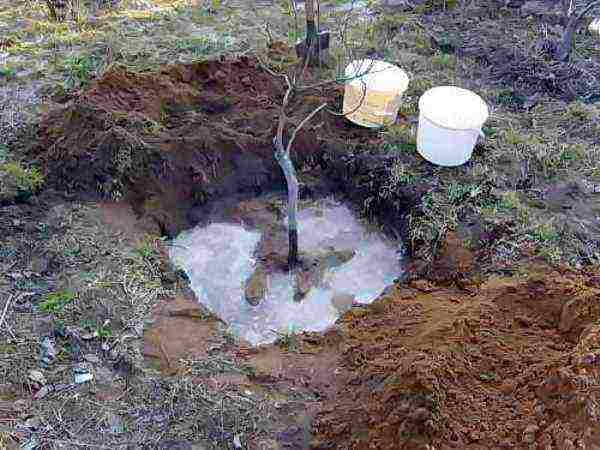
The resulting composition is poured into a pit and covered with infertile soil.... If the pit was not prepared in the autumn, then you can make up for lost time 2-3 weeks before planting. But in this case, the soil will be less fertile.
- Before boarding, you need place two support stakes in the pit.
- When lowering the seedling into the hole, the root collar should be on the 5-7 centimeters above ground level.
- When the seedling falls asleep it needs to be slightly shaken with earth so that all the voids between the roots are filled.
- Dig around the trunk hole depth 40-50 centimeters.
- Then trees are tied to a support, while the rope is not pulled too much, because it can damage the young plant.
- At the end of the procedure, drain thoroughly watered clean water, then mulch.
Care features
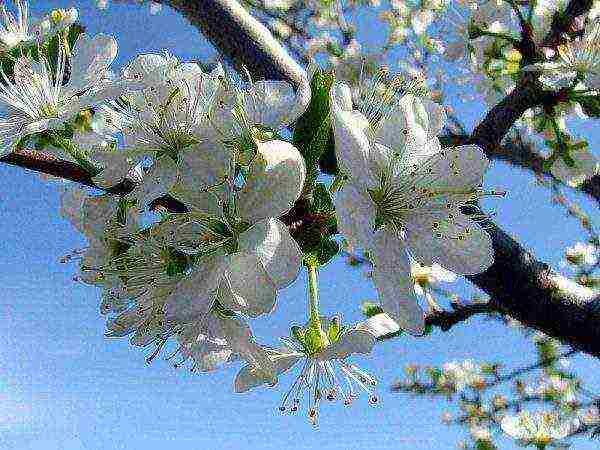
The main feature of Renclode plum care is the need for additional pollination... This procedure can be carried out artificially using special pollen, but many gardeners prefer to plant pollinators nearby.
Pruning plum
It is carried out strictly at the very beginning of spring, after the leaves bloom or at the beginning of June. These periods are the safest.
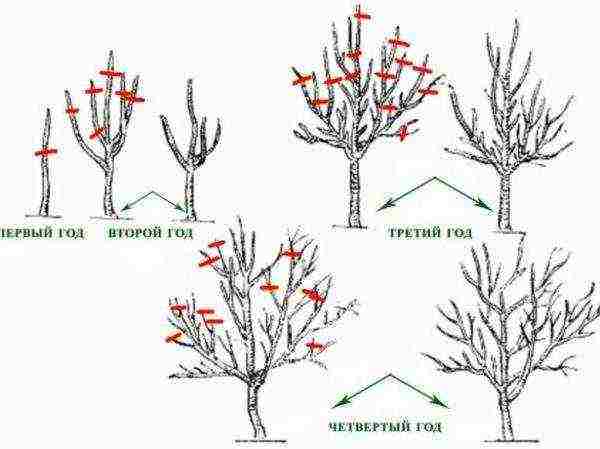
- First year... In order for the crown of the tree to be correct, spherical, you need to select 10 skeletal branches, with equal intervals and an angle of departure from the trunk, which should be equal to 45 degrees.
- Second year... All the resulting growths are cut off, leaving a length of only 25 centimeters.
- Third year... It is necessary to shorten the shoots that have grown from the skeletal branches and the conductor, their length should be 30 centimeters, the remaining growths are cut to a mark of 15 centimeters.
- Fourth year... Starting from the fourth year, the crown of the tree is considered to be formed. Therefore, now it is necessary to carry out only sanitary pruning, in which all dry and diseased branches are removed. You also need to ensure that the new shoots do not thicken the crown and let air and sunlight pass through themselves.
Top dressing
Usually the tree begins to feed from the 3rd year of planting, before that, it receives nutrients from fertilizers applied during planting.
- In April, before flowering, the following composition is poured under the tree:
- 25 grams of ammonium nitrate;
- 40 grams of potassium salt;
- 300 grams of mineral fertilizers;
- Then the plum is watered abundantly.
- During the flowering period, the tree is watered with a urea solution:
- 5 liters of water;
- 10 grams of urea.
- Then, after flowering, you need to add:
- 0.3% mullein solution;
- 50 grams of superphosphate.
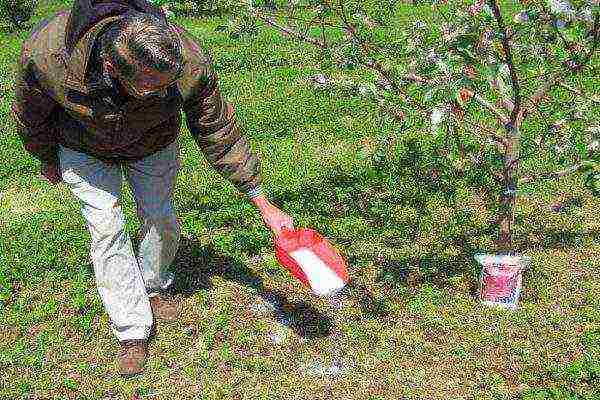
- During the ripening period of the fruits, the plum may require additional strength, which the following feeding can give it:
- 4 tablespoons of urea;
- 6 tablespoons of nitrophosphate;
- 20 liters of water.
- In the summer, approximately from 1 to 5 June the tree is sprayed with 1% carbamide solution.
- In the fall, they bring in for digging:
- 15 kg of manure or compost;
- 150 grams of superphosphate;
- 50 grams of ammonium nitrate.
- Same the plum should be poured with the following mixture:
- 4 tablespoons of sulfuric potassium;
- 6 tablespoons of superphosphate;
- 20 liters of water.
The plum should be watered using holes 35-40 centimeters deep., it is at this level that the root system is located. It is best to use warm, settled water. Experienced gardeners recommend watering the tree 5-6 times per season.The amount of water used for watering is determined by the age of the tree, on average, it is 4-8 buckets.
Preparing for winter
For the most part, all Renklods are afraid of cold weather, so they need to be prepared for the winter period:
- Young trees covered with spruce branches, hay or sedge, it can also be tied with paper.
- Mature trees do not require such protection, it is enough just to whitewash the stem and sprinkle it with humus or sawdust, their layer should be at least 10 centimeters.
Diseases and pests
Various varieties of the Renclaude family are distinguished by individual immunity to diseases and pest attacks. Most often, trees are affected by the following insects:
- Plum moth - it feeds on fruits, from which the plums begin to darken, then rot and fall off. To combat this pest, the following treatments are carried out:
- In early spring, the tree is sprayed with 0.3% Karbofos solution or 0.2% Metaphos solution.
- During the growing season, the plum is processed with a coniferous concentrate, 1 tablespoon per 3 liters of water.
- Plum aphid - plant growth slows down, fruit buds are practically not formed, all foliage withers. To drive away this insect, the plum is processed as follows:
- In early spring, at a temperature of at least -5 degrees, the plum is sprayed with mineral oil preparations, which can be purchased in garden stores.
- In April, the tops of young shoots are washed in a soap solution (300 grams of laundry soap per 10 liters of water).
- Plum moth - entangles leaves and fruits with cobwebs, which is why they wither and fall off. To get rid of the pest, carry out the following procedure:
- Spraying with Chlorophos, 3-4 liters per tree.
-
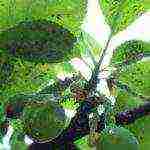
- Plum infested with aphids
-
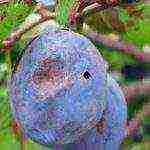
- Plum affected by moth
-
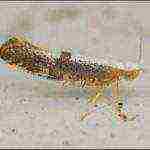
- Plum moth
The most common diseases include:
- Moniliosis - a fungal disease that provokes fruit rotting. When infected, the inflorescences wither, the leaves become covered with brown spots and fall off, the fruits are gradually covered with white rot, mummified and remain hanging on the branches. To combat the disease, use:
- The tree and the soil around it are treated with a 3% solution of the Horus preparation.
- All affected areas must be removed and burned.
- Gum therapy - the bark of the tree is strongly oozing out and a sticky, amber-colored liquid begins to ooze from it.
- To fight the disease it is necessary to remove all smudges and clean up the sore spot with a sharp knife, then be sure to process it with garden pitch.
-
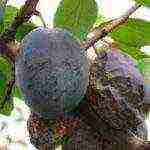
- Plum is affected by moniliosis
-

- Gum therapy at the plum
To avoid the appearance of pests or diseases, experienced gardeners recommend performing the following preventive actions:
- Necessarily needed loosen the trunk circle during autumn works.
- Trunk and skeletal branches cleaned of old bark.
- We must not forget about sanitary cuttings.
- All damaged branches and fruits are sure to burn.
- Needed regularly remove root growth and clear the near-trunk circle of foliage, branches, etc.
- Whitewashing the trunk will help to avoid the attacks of many insects.
- The crown of the tree should be good for air permeability and provide high-quality ventilation.
- When performing various procedures, it is best to avoid bark damage.
Plum propagation
Plum propagation occurs in several ways:
Planting seeds
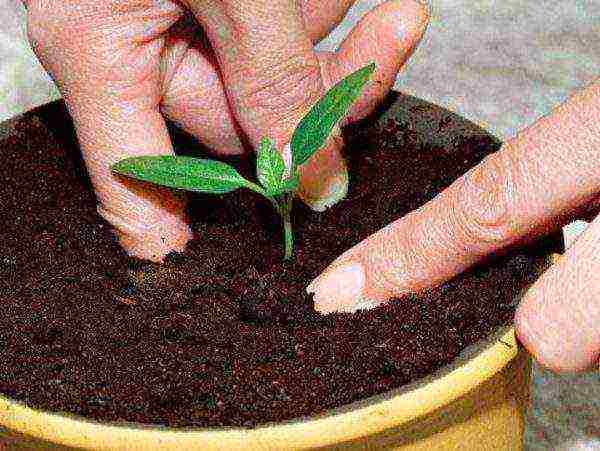
Usually this method is used to obtain rootstocks. To get a good seedling you need:
- Healthy and large seeds are thoroughly washed and cleaned of pulp, then soaked in water for 4 days, while the water must be changed, and the seeds must be stirred periodically.
- After this procedure, they are carefully dried and stored in a glass jar.
- Then you need mix seeds with wet sand or sawdust and leave them to infuse at temperatures from +1 to -10 degrees for 180 days.
- Initially seeds are germinated as seedlings, after which the seedlings are transferred to open ground.
Graft
This procedure is performed during the period of active movement of the juice, that is, in April-May or July-August. There are 2 main ways of grafting: in the cleft and behind the bark.
Root shoots
In the fall, the root that connects the mother plant and the shoot is cut, while in the spring the shoots are dug up together with the roots and transplanted to a new, separate place.
Root cuttings
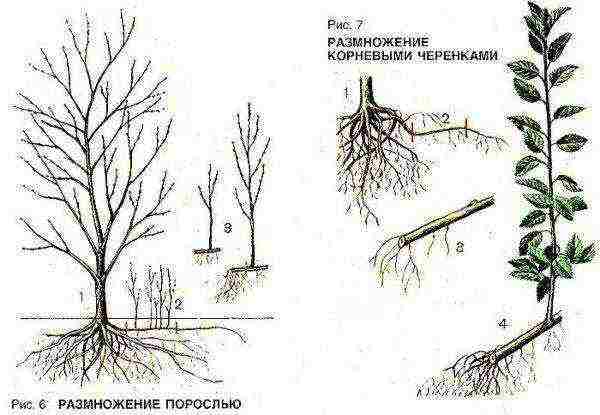
- By a young tree digging up the roots at a distance of 1 meter from the trunk, for adults the drainage distance increases to 1.5 meters.
- The length of the roots used should be 15 centimeters and 1.5 centimeters wide.
- If the cuttings were dug up in the fall, then their stored in a trench, 50 centimeters deep, sprinkled with a mixture of peat and sand. You can also save the cuttings in the basement by covering them with wet sawdust and moss.
- At the end of April, the soil should be preparedconsisting of one part peat mixed with 3 parts sand.
- Further into it obliquely or vertically cuttings are planted, then they are covered with a film.
- The upper ends are deepened 2 centimeters, then their mulch with sawdust or peat.
- Before the shoots appear cuttings must be protected from bright light and drying out.
- If several shoots sprout, then among them the strongest is chosen.
- Several times per season plants feed nitrogen fertilizers.
- For the winter period, shoots are moved to the house. and grow to a height of 1-1.5 meters, then the trees will be ready to move to the garden.
Plums belonging to the Renclode varieties are distinguished by excellent taste. Their pulp is called dessert or marmalade., therefore, every gardener dreams of growing such a tree in the garden. If you take the right approach to the choice of a seedling, then such a tree can be planted even in the central region of Russia.
